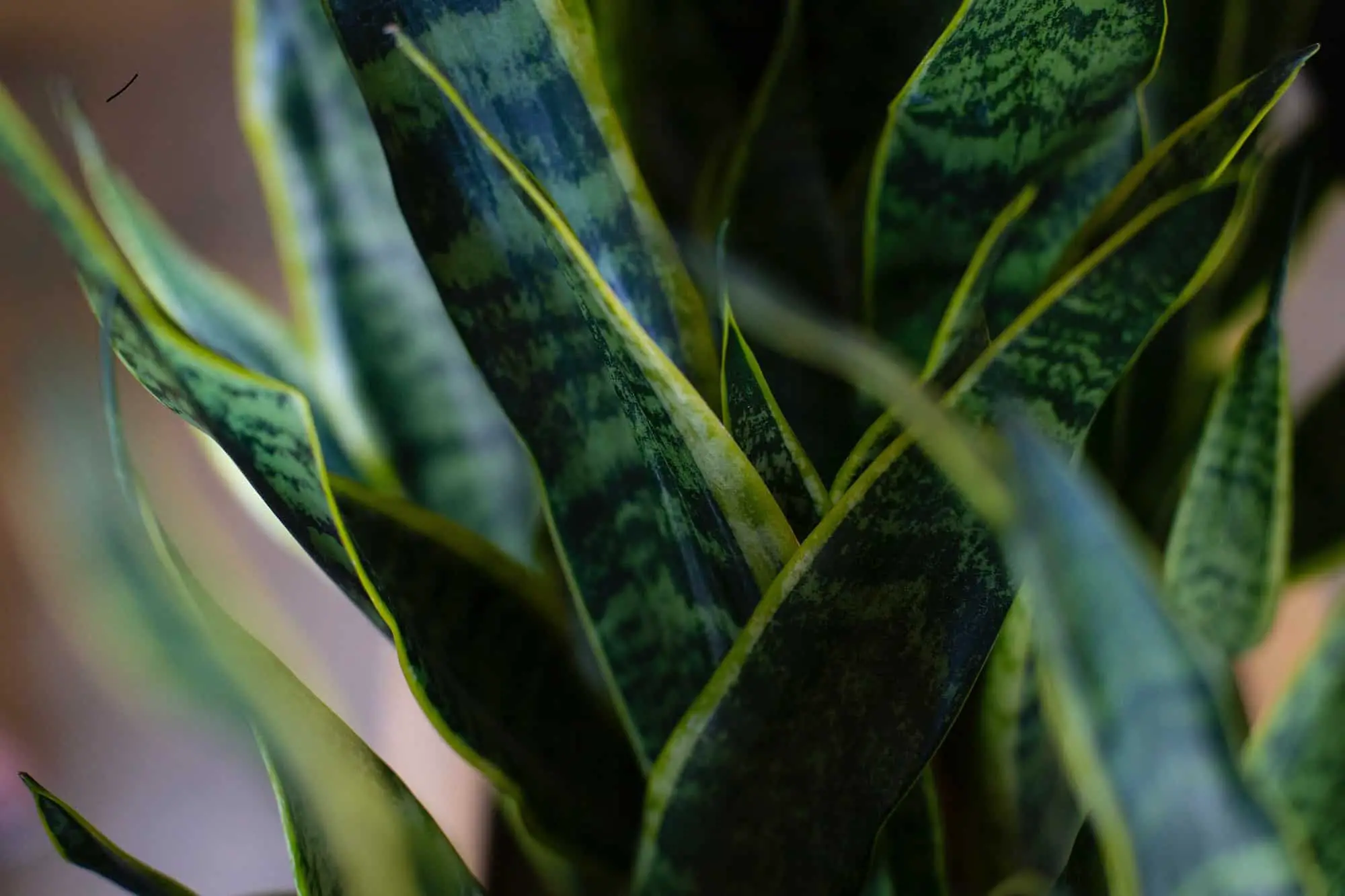Dracaena (Sansevieria) trifasciata is a species of flowering plant that belongs to the Asparagaceae family. It is commonly known as Snake Plant, Mother-in-Law’s tongue, Saint George’s Sword, or Viper’s Bowstring Hemp.
Snake Plant is a great houseplant for new plant owners because it is very hardy, does well in low-light conditions, requires little care, and is beneficial for indoor air quality.
The rest of this article will tell you everything you need to know about Snake Plant.
About Snake Plant
Before discussing how to care for a Snake Plant, I will talk a little bit about the biology of a Snake Plant as well as its cultural significance.
Snake Plant is native to the tropical climates of Nigeria to the Congo. It tends to grow very slowly. Snake Plant’s active growing season is during spring and summer.
Dracaena or Sansevieria?
If you have been researching Snake Plants, you may have noticed that some sources state that the scientific name is Dracaena trifasciata while others indicate that it is Sansevieria trifasicata. That is because the Sansevieria genus is now included in the Dracaena genus based on molecular phylogenetics studies. A study conducted by researchers at the University of Hawaii confirmed that this reclassification is appropriate (Lu and Morden, 2014).
History and Cultural Significance of Snake Plant
Although Snake Plant looks very modern, it has been popular in African, Chinese, and Japanese cultures for centuries. For example, Snake Plant was placed at the entrance of Chinese homes because it was believed that the plant allowed the eight virtues (Filial Piety, Sibling Harmony, Dedication, Trustworthiness, Propriety, Sacrifice, Honour, and Sense of Shame) to pass through.
Snake Plant was first described by Carl Peter Thunberg, who was a Swedish botanist and is also known as the Father of South African Botany. Thunberg brought the plant to Italy and named it after Prince Raimondo di Sangro, who was from San Severo. Prince Raimondo di Sangro was a patron of horticulture during the 18th century.
The Snake Plant has been grown in the United States since the 1920s. During the 1930s, more than half of the Snake Plants grown in Florida were sent to Europe for distribution. Today, the United States gets most of its Snake Plants from Central America and the Caribbean Islands.
Snake Plant still has cultural significance in parts of the world today. In many African countries, the leaves of the Snake Plant are used to produce fiber for things like ropes and baskets. The Snake Plant is also used as medicine because it has natural antiseptic properties.
In addition, Koreans give Snake Plants as gifts at housewarmings known as jipdeuri. This is because green plants represent prosperity and health.
Benefits of Snake Plant
As discussed in the section above, the Snake Plant is beloved around the world. Some of these reasons for this are listed below.
Snake Plant Is Hard to Kill
One of the biggest benefits of owning a Snake Plant is that they do not have very stringent care requirements and can survive in less than ideal conditions. Snake Plants can survive in low light conditions and do not need to be watered very often. Snake Plant was popular during Victorian times because it was one of the only plants that could survive in their dark homes.
Because they require such little care and are so hardy, they are perfect plants for new houseplant owners and travelers. You will also frequently find Snake Plants as decorations in offices and hotels. They are also in a lot of movies. This is probably because they require very little attention on set.
Snake Plant Filters Air
During the last couple of decades, there has been a greater emphasis on improving indoor air quality (IAQ) because it has a significant impact on human health. This is particularly important because urban dwellers spend about 90% of their time indoors (US EPA, 2000) where the air quality tends to be worse than the air quality outside.
Studies have shown that some houseplants effectively remove pollutants and improve IAQ. For example, a study conducted by researchers at Brawijaya University found that a botanical biofilter comprised of Snake Plant and Spider Plant effectively removes volatile organic compounds (VOCs), formaldehyde, acetone, benzene, and xylene (Siswanto et al. 2009).
In a study that examined the benzene removal efficiency of eight houseplants, it was found that Snake Plant had the highest removal efficiency (Treesubsuntorn and Thiravetyan, 2012).
Another study conducted by researchers at the King Mongkut׳s University of Technology Thonburi found that Snake Plant efficiently removes toluene, which is the pollutant associated with the smell of paint thinner, from the air (Sriprapat et al. 2014).
Research has even found that Snake Plant effectively removes trimethylamine (fish odor) from the air (Boraphech and Thiravetyan, 2015).
Finally, Snake Plant is a good plant to put in your bedroom because it removes carbon dioxide and emits oxygen, especially at night. This is because Snake Plant, like many succulents, is a Crassulacean-Acid Metabolism (CAM) plant. This means that the plant opens its stomata at night in order to absorb carbon dioxide and release oxygen.
Snake Plant Is A Good Feng Shui Plant
Snake Plant is also a good feng shui plant that is said to provide positive energy to one’s space. The long, sleek leaves of the Snake Plant stand tall and give off a protective energy. This protective energy makes the Snake Plant ideal for entryways.
For those who are unfamiliar with the principles of feng shui, here is a very brief overview:
The philosophy of feng shui, commonly known as the art of placement, involves modifying the built environment (i.e., our homes) so it will be in harmony with the natural world. Feng shui was developed about 3,000 years ago in China. In Chinese, “feng” means wind, and “shui” means water. In ancient Chinese culture, wind and water were associated with good health. Therefore, feng shui is associated with good health and fortune.
The objective of decorating in accordance with feng shui principles is to create a space with a positive energy flow. In other words, a feng shui space would have a restful atmosphere rather than a stressful, cluttered appearance.
Cultivars of Snake Plant
There are several different types, or cultivars, of Snake Plant. A cultivar is a plant variety that has been produced through selective breeding.
Some people refer to all plants that belong to the Sansevieria/Dracaena genus as Snake Plants, but this list will be comprised of various varieties of Dracaena trifasciata.
Dracaena trifasciata ‘Black Gold Superba’
This type of Snake plant is also known as Good Luck Plant and Black Gold Snake Plant. The Black Gold variety of Snake Plant has tall leaves that are 3-4 inches wide. The leaves are dark green with yellow edges.
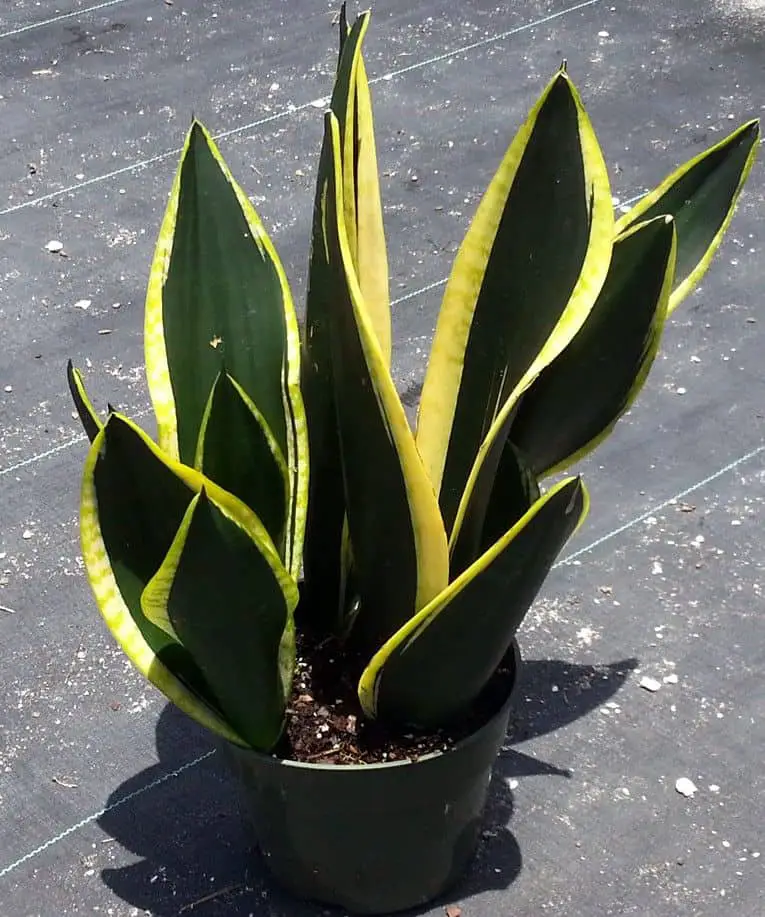
Dracaena trifasciata ‘Futura Robusta’
Futura Robusta is another variety of Snake Plant with a dense stand of leaves that form a rosette. It looks like a smaller version of Black Gold Superba, but the leaves are wider. The leaves grow up to 24 inches in height. These leaves are variegated and are gray and green in color.
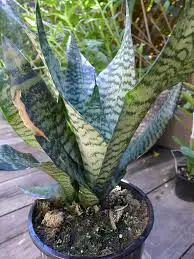
Dracaena trifasciata ‘Twisted Sister’
Twisted Sister is also a dwarf variety that grows to a height of at least 15 inches. The leaves are variegated with bright green and yellow colors. This cultivar is unique because the leaves twist as they emerge from the base of the plant.
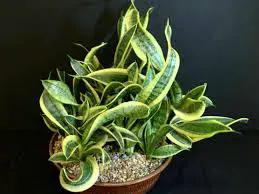
Dracaena trifasciata ‘Golden Hahnii’
Golden Hahnii, also known as Golden Bird’s Nest, is a dwarf variety of Snake Plant. The leaves only grow to a height of about 8 inches, and the leaves form a rosette. This is the brightest cultivar of Snake Plant with gold edges and green center.

Dracaena trifasciata ‘Futura Superba’
Future Superba is a variety of Snake Plant with variegated green leaves. This cultivar has irregular rosettes and is another widely available variety of Snake Plant.
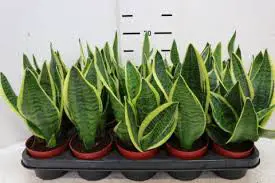
Dracaena trifasciata ‘Laurentii’
Laurentii is a tall variety of Snake Plant with the leaves reaching a length between 3 and 4 feet. This is probably the most popular and widely available cultivar of Snake Plant. The plant will sometimes produce small, pale green blooms followed by orange berries.
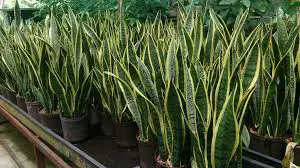
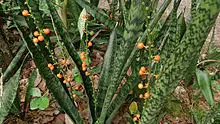
Dracaena trifasciata ‘Moonshine’
This cultivar of Snake Plant is sometimes called Silver Snake Plant. This variety of Snake Plant is unique because it has silvery leaves rather than dark green leaves. However, the leaves will turn a darker green color when exposed to low light conditions. The leaves tend to be between 3 and 4 inches wide and can grow to a length of 2 feet. Silver Snake Plant won the Royal Horticultural Society’s Award of Garden Merit in 1993.
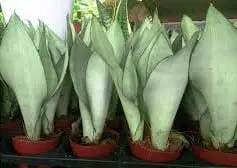
Dracaena trifasciata ‘Green Mermaid’
Dracaena trifasciata ‘Green Mermaid’ is derived from Dracaena trifasciata ‘Black Gold.’ Green Mermaid was first discovered in December 2012 at a nursery in Costa Rica.
Although this variety is similar to the Black Gold cultivar, there are a few characteristics that make Green Mermaid unique. For example, the leaves of the Green Mermaid curve inward rather than outward like other types of Snake Plant. The leaves are also distinctively strong and fibrous. Finally, the leaves are dark green with a grey-green striation.
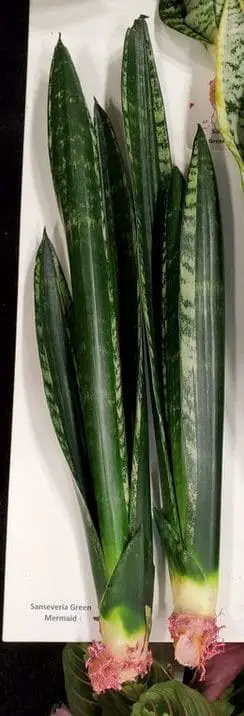
Dracaena trifasciata ‘Black Jack’
Black Jack is a compact cultivar of Snake Plant. It is derived from its parent plant, Dracaena trifasciata ‘Black Gold Superba.’ It is shorter than Black Gold Superba and has more leaves per rosette than the parent plant and has green foliage with brilliant yellow-green margins.
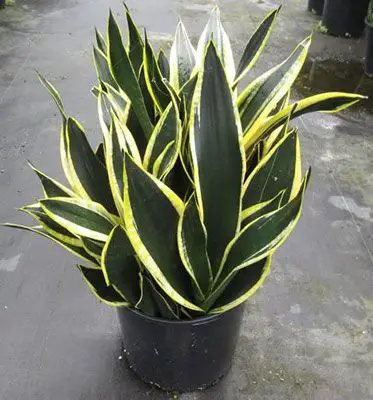
Dracaena trifasciata ‘Whitney’
The Whitney cultivar is another compact Snake Plant variety with an inverted pyramid shape. It was discovered by Marvin Gonzalez Villegas in Costa Rica in 2006. It originated as a naturally-occurring mutation of the Black Gold Superba variety.
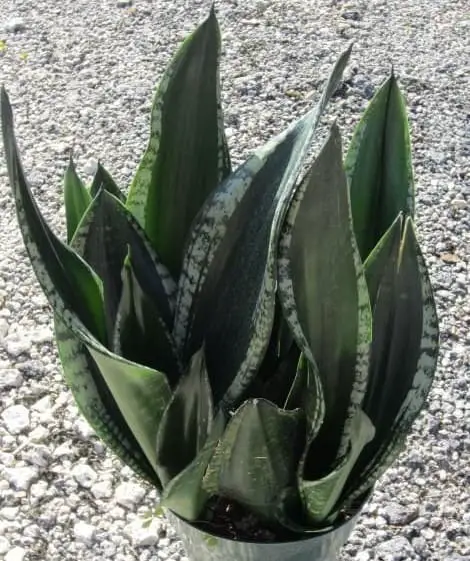
Flowering
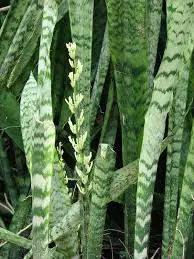
Snake Plant does produce flowers but not very often. The flowers are typically white or pale green. Snake Plants will tend to bloom when they are mildly stressed.
Some people believe that applying additional fertilizer will encourage your Snake Plant to bloom, but this is not true. Rather, plenty of light and little water will cause your Snake Plant to bloom.
Snake Plant does not die after flowering. However, it will cease to grow more leaves after flowering.
Watering Snake Plant
Snake Plant does not need to be watered very often. Only water your Snake Plant after allowing the top 2-3 inches of soil to dry completely. I water my Snake Plant every 2-3 weeks. Depending on the temperature and humidity of your home, you may need to water your Snake Plant more or less often. During the winter months, I water my Snake Plant even less frequently. Brown tips are a sign of underwatering.
Overwatering is the most common way to kill a Snake Plant. This type of plant thrives on neglect. Overwatering can cause root rot. Signs of overwatering include mushy roots or mush leaves. Overall, it is better to err on the side of slightly underwatering your Snake Plant rather than overwatering.
Saving An Overwatered Snake Plant
Unfortunately, it is difficult to rescue an overwatered plant, but it is possible in some cases. If you suspect that your Snake Plant has been overwatered, take your plant out of its pot and cut off any dead or dying roots. Then remove any soaking wet soil from the root ball and place the wet root ball/soil on top of some dry newspaper. Change the newspaper every 2-3 hours as it soaks up excess moisture.
Leave the roots exposed overnight. Then repot the plant in fresh, dry potting soil. Make sure you clean the pot to ensure that all potentially harmful bacteria is removed from the pot. When you do water the plant, add about 1 tbsp of hydrogen peroxide to control fungus gnats, which love wet soil.
Lighting Requirements For Snake Plant
Like all plants, Snake Plant needs light to survive. However, Snake Plants are considered one of the best houseplants for low light conditions. The varieties with darker leaves tend to do better in low light conditions than the varieties with bright colors or variegated patterns.
Snake Plants prefer to be about 3-6 feet from a north-facing window. If Snake Plant is exposed to light that is too intense, the leaves will burn. Too little light can result in less vibrant coloring. Snake Plants will also start to develop white spots on their leaves when exposed to excessive light.
Snake Plants are a good plant for low-light conditions. However, they may not look as nice after being in a low-light environment for a while. To get around this issue, some plant owners will rotate their Snake Plant with another low-light plant. If you want to put a plant in a less-than-ideal location for plants, put a Snake Plant in that particular spot. After a couple of weeks, switch that Snake Plant with another low-light plant that has been living in a more plant-friendly location. This technique will allow you to decorate the way you want while making sure your plants remain happy and attractive.
Dust Removal
In order to ensure that your plant is receiving enough sunlight, it is also important to wipe the dust off of the leaves regularly. Dust blocks a plant’s ability to absorb sunlight and photosynthesize.
To determine whether your Snake Plant needs to be cleaned, run your fingers across a leaf. If a layer of dust accumulates on your finger, it is time for a cleaning. I recommend cleaning the leaves about once a month. You may need to wipe down the leaves more frequently if you live near a dirt road or a construction site.
To clean the dust off of your Snake Plant’s leaves, simply run a wet cloth across the leaves. Do not use any soap or other cleaning products as they can damage the leaf tissue. Then use a clean, dry rag to wipe off any excess moisture or remaining dust.
Best Soil Mix For Snake Plant
Like most succulents, Snake Plants does not do well in soil that holds too much moisture. That is why it is important to put your Snake Plant if a well-draining soil. I recommend purchasing a succulent or cactus mix unless you are going to make your own soil.
Mixing your own soil is better than using cactus/succulent mixes sold in the store because even cactus/succulent soil mixes can hold a little too much moisture for Snake Plant. In addition, making your own soil is often cheaper than purchasing specialty soil mixes. An example of a good soil mix for Snake Plant is as follows:
- 2 parts potting soil (generic potting mix, this doesn’t need to be succulent potting mix)
- 2 parts coarse sand
- 1 part pine bark or mulch
- 1 part perlite
Do not substitute vermiculite for perlite. Although they are both used to improve soil aeration, vermiculite does not improve soil aeration as much as perlite. This is because vermiculite tends to soak up a lot of water.
You can put add a little compost to your soil mix. Just keep in mind that compost can hold a lot of moisture so don’t add too much compost.
Selecting The Right Pot For Snake Plant
The pot you use for your Snake Plant should be large enough to barely fit the root system. Snake Plants do better when they are potbound because this prevents root rot and overwatering.
When selecting a pot for your Snake Plant, make sure you get a pot that is wider than it is deep. This will prevent the plant from tipping over. It is also important to put your Snake Plant in a pot with drainage holes so that excess water can exit the pot.
If you are especially concerned about potential overwatering issues, I recommend putting your Snake Plant is a terra cotta or clay pot. The clay material is porous and allows water to pass through the pot. Alternatively, you can place the nursery pot into a plant basket as shown below.
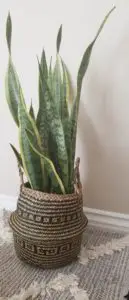
Repotting Snake Plant
In general, you should repot your Snake Plant every 2 to 6 years. It is important to repot plants every couple of years because potting soil loses its nutrients over time. In addition, transferring your Snake Plant to a slightly larger pot will encourage it to continue growing.
Some signs that you need to repot your Snake Plant are:
- The roots are growing out of the pot/container and its drainage holes.
- Bulging pots (applicable only if your plant is in a plastic pot).
- Cracks in a clay pot.
- Visible roots on the surface of the pot.
- The plant needs to be watered more frequently than usual.
In general, it is best to repot Snake Plants during late winter/early spring when the plants are not actively growing. This will ensure that you are not stressing the plant too much.
To repot your Snake Plant, you will first need to remove the Snake Plant from its current pot. To do this, grab the plant by the base and turn the pot upside down. Then gently shake the plant loose from the pot.
After you have removed the plant from its old pot, inspect the root ball. Cut off any dead or dying roots. In addition, remove any wet soil. If you see large roots wrapping around the root ball, use a knife to slice through it. This will prevent the roots from spiralizing and becoming root bound in the pot.
Make sure that your new pot is dry and clean. The verify that the drainage holes are not obstructed by soil or debris. Finally, place wire mesh or cloth over the drainage holes to prevent soil from escaping through the drainage holes.
Finally, put your Snake Plant in its new pot. Fill the pot with a few inches of soil and place the Snake Plant in the pot and fill in the remaining space with soil. Make sure that you do not bury the leaves.
In order to prevent transplant shock. remove any diseased or dead roots from the root ball. In addition, do not fertilize your Snake Plant for at least a month after re-potting so the roots can re-establish themselves.
Although SnakePlants grow fairly slowly, it is a good idea to put your Snake Plant in a larger pot when repotting. In general, your new pot should have a diameter that is about 2 inches larger than the old pot.
Fertilizing Snake Plant
Snake Plants do not require much fertilizer, but they will grow a little faster if you fertilize them during their growing season (spring and summer). If you have added a little bit of compost to your soil mix (as discussed above), you do not need to fertilize.
Otherwise, use an all-purpose houseplant fertilizer once or twice during the growing season.
Ideal Temperature Range For Snake Plant
Snake Plants can tolerate a wide range of temperatures in your home. They will do best in daytime temperatures between 60°F and 80°F and nighttime temperatures between 55°F and 70°F.
Avoid placing them close to a hot fireplace or extremely drafty window or door. These plants will not tolerate frost or prolonged periods of cold temperatures.
Snake Plants are not sensitive to humidity or air circulation. They will do well in dry air or in humid bathrooms.
Pests
In general, these plants do not have many pest problems, especially if they are receiving proper care. The most common pest problem for Snake Plant is thrips which are very small (<1 mm), slender black bugs. Thrips damage plants by sucking the juice out of the leaves which causes the leaves of the plant to curl. Thrips are very small and difficult to see, but they appear as tiny black specks.

To get rid of thrips, remove infected leaves using a sharp kitchen knife. Then use a wet cloth to wipe down the remaining leaves to ensure you remove all bugs from the plant. You could also use a mild insecticidal soap to clean the leaves.
Other common pests include aphids, mealey bugs, and spider mites.
Growing Snake Plant Outdoors
Snake Plants are winter hardy in United States Department of Agriculture (USDA) hardiness zones 9b through 11. Ideally, they should be planted in soil with a pH between 5.5 and 7.5.
In some areas, Snake Plants will do well outdoors during the warmer months. However, you should bring them inside prior to the first frost. Snake Plants do not tolerate frost.
Propagating Snake Plant
Propagation is a free way to clone new plants from plants that you already own. The most common ways to propagate Snake Plant are listed below.
Propagate Leaf Cuttings in Water
To propagate Snake Plant in water, first choose a container that is tall enough to hold the leaf. Then select a healthy leaf for propagation and cut it off using a sharp knife. Put the end of the leaf cutting in enough water to cover the bottom quarter of the leaf cutting. Then place the container in a spot with indirect light and change the water every couple of days. Eventually, roots will appear. Plant the rooted cutting in a well-draining soil.
Propagate Leaf Cuttings in Soil
To propagate Snake Plant from leaf cuttings, take a cutting of Snake Plant. Allow the leaf cut to callus over for a couple of days. Then simply insert the cut end into a pot of fresh, well-draining soil. The cutting will root in a few weeks.
Rhizome Division
Most varieties of Snake Plant with variegated leaves are actually chimeras which is a type of genetic mutation. A chimera actually contains the genetic material of two individuals. In other words, chimeras are two genetic individuals in one organism. Another example of a chimera is a cat with two different eye colors as shown in the picture below.

Chimeras cannot be propagated from leaf cuttings. The propagated plant will lose its patterning and will be completely green. However, you can still propagate variegated Snake Plants via rhizome division. The video below describes how to propagate Snake Plants through rhizome division.
Toxicity to Pets
According to the American Society for the Prevention of Cruelty to Animals (ASPCA), Snake Plant is toxic to dogs and cats. Ingesting Snake Plant can cause your pets to have nausea, vomiting, and diarrhea. If you believe that your pet may have ingested a potentially toxic substance like Snake Plant, call your veterinarian immediately.
Snake Plant causes these symptoms because it contains saponins which are glycosides with a distinctive foaming characteristic. Saponins can actually be found in many plants such as spinach and help the body digest calcium and silicon. However, some plants (like Snake Plant) contain an abundance of saponins or dangerous saponins.
References
Boraphech, P. and Thiravetyan, P. Removal of trimethylamine (fishy odor) by C3 and CAM plants. Environ Sci Pollut Res 22, 11543–11557 (2015). https://doi.org/10.1007/s11356-015-4364-3
Lu, Pei-Luen and Morden, Clifford. (2014). Phylogenetic Relationships among Dracaenoid Genera (Asparagaceae: Nolinoideae) Inferred from Chloroplast DNA Loci. Systematic Botany 39(1): 90-104. March 2014.
United States Environmental Protection Agency (2000) “Healthy buildings, healthy people: a vision for the 21st century”, Office of Air and
Radiation.
Siswanto, Dian; Permana, Bayu Hadi; Treesubsuntorn, Chairat; and, Thiravetyan, Paitip. Sansevieria trifasciata and Chlorophytum comosum botanical biofilter for cigarette smoke phytoremediation in a pilot-scale experiment—evaluation of multi-pollutant removal efficiency and CO2 emission. Air Qual Atmos Health 13, 109–117 (2020). https://doi.org/10.1007/s11869-019-00775-9.
Sriprapat, Wararat; Suksabye, Parinda; Areephak, Sirintip; Klantup, Polawat; Waraha, Atcharaphan; Sawattan, Anuchit; Thiravetyan, Paitip. (2014). Uptake of toluene and ethylbenzene by plants: Removal of volatile indoor air contaminants. Ecotoxicology and Environmental Safety 102, 147-151 (April, 2014).
Treesubsuntorn, Chairat and Thiravetyan, Paitip. (2012). Removal of benzene from indoor air by Dracaena sanderiana: Effect of wax and stomata. Atmospheric Environment 57, 317-321.

